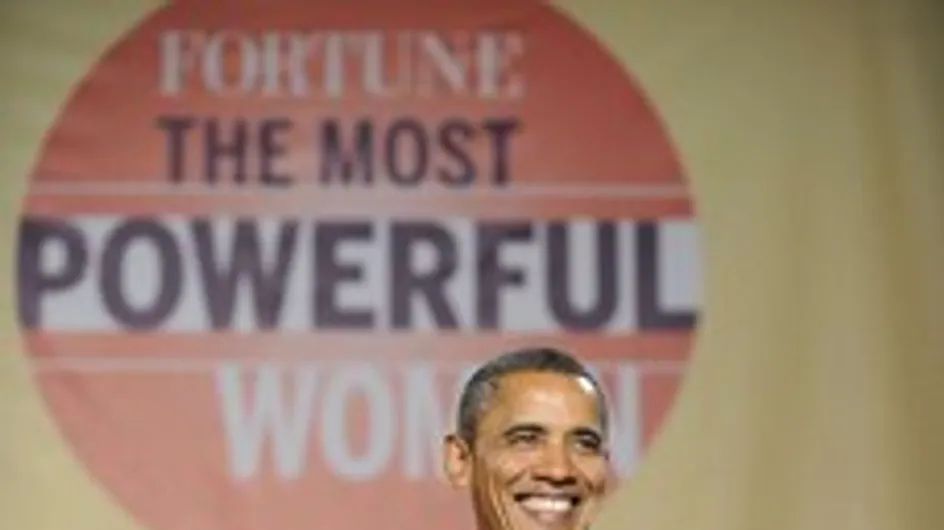The right to vote was brought in as early as 1893 in some states but there is yet to be a female president.
However equal rights and other puported women's issues are still at the forefront of American politics.
50.8% of American citizens are women (US Census Bureau, 2010) so politicians know they must win over these voters to win an election.
We look back at who's done what from women since the 1988 elections. In the battles for equal rights there's still a long way to go...

1989 - 1993
1993 - 2001
2001-2009
2009 -
____________________________________________
Women's issues in the 1988 Election
equal rights, abortion, rape, day care
The 1988 presidential election between Republican Vice President George H. W. Bush and Massachusetts Democratic Governor Michael Dukakis represented a stark choice on women’s issues.
Vice President Bush was running on the record of the Reagan Administration, which women voters predominately saw as a regressive era for issues such as abortion rights and equal opportunity in the economy.
From removing the Equal Right Amendment from the GOP platform to the “Mexico City Policy” (which dramatically reduced funding for international family planning), cutting of school lunches, and more, the very conservative actions of the Reagan Administration clung to Vice President George H. W. Bush in the 1988 election.
Like Reagan, Vice President George H. W. Bush was pro-life. That said, the Religious Right had always been lukewarm about the Vice President, a dilemma that Bush sought to remedy by choosing Senator Dan Quayle as his running mate in 1988.
During the campaign, Senator Quayle caused a bit of a stir when he affirmed that abortion should not be allowed even in cases of rape and incest, a position more conservative even than the one taken by the Vice President’s himself.
Governor Michael Dukakis, by comparison, was much more in lockstep with issues cherished by many women voters.
He was a firm supporter of abortion rights, equal pay, more funding for daycare, and other issues near and dear to many women voters.
Despite his solidly liberal record on women’s issues, he suffered politically from the Republican’s successful portrayal of him as weak on crimes targeted against women.
The notorious Willie Horton ad pointed out that Governor Dukakis supported the Massachusetts prison furlough program, a program that allowed convicted murderer Willie Horton to be released and subsequently rape and assault a woman
While this was in keeping with the Bush campaign’s efforts to depict Dukakis as a “Massachusetts liberal” who was weak, some of Dukakis’ worst wounds were actually self-inflicted.
During a debate, Dukakis was asked if would hypothetically support the death penalty for a man who raped and murdered his own wife, Kitty Dukakis. Many voters viewed Governor Dukakis’ statistics-driven answer as too emotionally detached.
In the end, women’s issues may have mattered less in 1988 than in other election cycles.
While Governor Michael Dukakis started off with a substantial gender gap, that gap had closed dramatically by election day, in keeping with the overall Bush lead that would result in a landslide defeat for the Democrats.
More than women’s issues, the election hinged on voters’ uncertainty about the strength of Governor Dukakis’ leadership during a time when the United States was still in the midst of the Cold War.
____________________________________________
Women’s Issues in the 1992 Election
domestic issues; sexual harassment
The 1992 presidential election was a watershed moment in the history of women’s issues, and in the political participation of women voters.
A number of events contributed to this development. First was the end of the Cold War, and the subsequent ascendancy of domestic issues in the public consciousness.
The threat of the Soviet Union was gone, and now the American people could turn their focus inward - on the nation’s crumbling infrastructure, under-funded schools, and rampant crime.
Domestic issues were more important to women voters than to men, simply because women tended to be more directly affected by these issues. Women were paid 60 cents on the dollar relative to their male counterparts in the workplace.
Also, women were more likely to be victims of violent crimes. And so the political arena’s shift to domestic issues inevitably led to a more involved female voting bloc.
As the 1992 election approached, the country suffered from a recession. As is usually the case in economic hard times, incumbents take the blame, so President George H. W. Bush was already in trouble.
His administration’s standing with women suffered even more with the Clarence Thomas-Anita Hill controversy. Despite Anita Hill’s testimony, and her successful polygraph test regarding her sexual harassment claims, Clarence Thomas was confirmed to the U.S. Supreme Court.
Many political observers have concluded that Anita Hill’s treatment galvanized women voters and politicians alike, and that helped feed the successful election of Democratic Arkansas Governor Bill Clinton.
Here are a few things that are known for sure. Women’s political organizations wielded unprecedented power in the 1992 campaign.
Groups like Emily’s List doubled in membership in one year alone and quadrupled their funding. Also, more women ran for office in 1992 than in any previous election year in U.S. history.
Ultimately, despite a three person race between President George H. W. Bush, Independent candidate Ross Perot, and Governor Bill Clinton, the relatively obscure Democratic contender managed to garner 46% of the women’s vote (compared to 41% of men’s vote).
That is a testament to the shift, not only to the primacy of domestic issues, but also a lasting view among women that these issues were better addressed by Democratic policies.
Not only did the confirmation of Clarence Thomas rankle women because of the claims of sexual harassment, but also because of fears that Roe v. Wade might not actually be as invulnerable as previously thought.
Pro-choice voters were a solid bloc for the Democratic Party, and would continue to be so.
____________________________________________
Women’s Issues in the 1996 Election
welfare, healthcare, abortion
In many ways, Democratic President Bill Clinton positioned himself fantastically with women voters by the eve of the 1996 election. With such legislative victories as the The Family and Medical Leave Act and the Violence Against Women Act under his belt, Clinton had solidified his image as a strong supporter of women’s issues.
Nevertheless, the loss of Congress to the Republicans ushered in a period of gridlock, and one of the “centrist” pieces of compromise that were born from that period was the Personal Responsibility and Work Opportunity Reconciliation Act of 1996.
This welfare reform bill, among other things, instituted stricter food stamp eligibility criteria and recipient work requirements, and as well as reduced immigrant welfare assistance.
That did not sit well with many liberal advocacy groups that felt Clinton had ultimately caved to the conservatives, led by GOP House Speaker Newt Gingrich. Clinton was renowned for his political strategy of “triangulation” (first coined by Clinton advisor Dick Morris, this was the art of neutralizing your political opponent by subsuming some of his or her ideas into your policies), but the left saw welfare reform as a bridge too far.
At the same time, however, Clinton was never in any real danger of losing the women’s vote to his Republican opponent, Senator Bob Dole, who he went on to defeat in an electoral landslide.
Dole’s positions on women’s issues like healthcare (free market solutions and more leeway for state governments), abortion (pro-life, though he reversed his earlier support for a Constitutional amendment banning abortion), and others did not woo many women voters to his side come November.
In the end, President Bill Clinton garnered 53% of the women’s vote, compared to Dole’s 38% (the only president to win a larger portion of the women’s vote was President Barack Obama, who in 2008 took 56%).
What it really came down to for women was the underlying difference in Clinton and Dole’s views on the role of the federal government.
President Bill Clinton, as a standard bearer for fundamental Democratic principles, believed that the government had a vital role to play in securing the economic future of the individual American, while Senator Bob Dole argued that individuals should be entrusted more with their own money.
But in a time of strong economic prosperity, the claim that the country needed a radical new direction was not one that many Americans were very receptive to.
Specifically, Dole’s argument that Social Security needed urgent reform, or that cuts were needed in Medicare and Medicaid, fell on deaf ears, especially when it came to women, for whom these types of programs were crucial to their daily lives.
____________________________________________
Women’s Issues in the 2000 Election
abortion, universal healthcare
At the time of the election in 2000, many people felt as if there was not that much daylight between Vice President Al Gore and Texas Governor George Bush on women’s issues.
This view arose in part from George Bush’s effective self-branding as a “compassionate conservative.”
While many of Bush’s detractors would later argue that he failed to live up to that image once he reached office, it was in many ways a successful campaign strategy.
Some of his statements about abortion, for example, portrayed his views as more conciliatory than those of conservative firebrands like Pat Buchanan.
He argued for a consensus between liberals and conservatives in the effort to reduce the number of abortions and stated that a mother’s decision to get an abortion should not be criminalized (though of course he believed it should not be legal).
The choice of Vice President Al Gore as the Democratic candidate further muddied the waters. As a Southern Democrat, Gore had taken a number of positions on women’s issues that were centrist.
For example, he originally voted against Medicare-funded abortions when in Congress, though he supported it by the time of the 2000 election.
Indeed, in 1984, he was quoted as saying that “abortion is arguably taking a life,” though in fairness, he had a genuinely evolving view on abortion in the twenty years since that could not be reduced simply to political pre-positioning.
The other element in the 2000 race that further accentuated the small gap between Gore and Bush was the Green Party candidate and former consumer advocate, Ralph Nader. Nader and his supporters took great pains to point out that Gore was far from a dyed-in-the-wool liberal on women’s issues.
Specifically, Ralph Nader pointed out some of Gore’s past hedging on abortion rights, his support of conservative Justice Antonin Scalia (reviled by pro-choice groups) to the Supreme Court, and his half-hearted support for universal healthcare (Gore supported universal healthcare, but not a government-administered program).
Bush’s conservative public policy during the eights years of his presidency cast a new light on the judgments made during the 2000 election.
In hindsight, most politically savvy observers would argue that Al Gore would have presided over a dramatically more liberal public policy had he won the White House.
As a result, some blame Ralph Nader’s efforts to paint Gore and Bush as politicians cut from the same cloth when it comes to women’s issues.
Despite losing the election to Governor George W. Bush, Vice President Al Gore did win the women’s vote by the considerable margin of 57 to 43 percent.
____________________________________________
Women’s Issues in the 2004 Election
social security, wage, abortion,
The general election candidates in 2004 represented a stark contrast on women’s issues.
President George W. Bush campaigned on “compassionate conservatism” in 2000, but as his first term came to an end, many independent voters felt disenchanted with his domestic policies, including his administration’s approach to women’s issues.
Senator John Kerry (D-MA) had a consistently liberal track record on social issues like abortion, equal pay, and healthcare coverage. Certainly Bush’s “compassionate conservatism” was evident in his campaign against the spread of HIV abroad.
Even liberals have commended the Bush administration’s commitment to eradicating this epidemic in places like Africa.
At the same time, however, Bush took some actions that rankled independent and liberal women voters, including his decision to de-fund abortion rights groups operating in foreign nations.
Also, during his first term in the White House, the wage disparity between men and women increased.
In 2004, the value of a women’s wage was less than what it was worth in 1996, the last time the minimum wage was raised. Senator John Kerry proposed raising the minimum wage from $5.15 to $7, while President George W. Bush proposed raising it by one dollar, and allowing states to opt out. Social Security was also a prominent issue for women voters in 2004.
Often referred to as the “third rail of politics,” Social Security became an increasingly red button issue in the campaign after Bush tried and failed to change the current system to one of private accounts (decried as the “privatization of Social Security” by most Democrats, though Republicans disputed that characterization).
At the time of the election, Social Security represented the sole source of retirement income for 26 percent of unmarried eligible women.
Many liberals also asserted that Bush did not effectively enforce Title IX, which protects equal opportunities for women in education (particularly sports).
As a candidate, Kerry promised to defend Title IX if he won the election. Finally, the difference between the two candidates on the issue of abortion could not have been more dramatic.
Bush was a staunch pro-life supporter, while Kerry was firm in his defense of a woman’s right to choose.
That said, it was readily apparent that President George W. Bush was not as comfortable wading into extreme debates on social issues as were others in his party.
Many conservatives expressed disappointment that Bush did not push harder to roll back abortion rights. Despite losing the overall election, women preferred Kerry over Bush by a 4-point difference.
____________________________________________
Women’s Issues in the 2008 Election
healthcare, economy, equal pay,
The debate over women’s issues in the 2008 general election arose from fundamental disagreements about healthcare policy.
Senator Barack Obama (D-IL) subscribed to the left-wing notion that it is incumbent upon the federal government to provide universal healthcare to American citizens.
In contrast, Senator John McCain (R-AZ) adopted the fundamental conservative view that a “government takeover” of healthcare would reduce the quality of care and raise costs.
He opposed mandatory healthcare, instead favoring a system of tax credits, and the option for individuals to purchase nationwide healthcare policies rather than be restricted to in-state plans.
The issue of healthcare was a particularly salient one for women during the 2008 election. In 2008, 12.4 million women of child-bearing age lacked health insurance coverage.
Over seven in ten women were either under-insured or not insured at all, and studies find that women had a much more difficult time accessing affordable healthcare than men. Lack of healthcare coverage for preventive medicine was also an issue near and dear to many women voters.
In 2010, President Barack Obama signed the Patient Protection and Affordable Care Act, the nation’s most sweeping overhaul of a major social program in decades.
In any discussion about the differences in these two candidates’ views on women’s issues, one must place the debate into proper historical context. The preeminent issue at stake in the 2008 election was the economy.
Leading into the November, 2008 election, the nation’s monthly unemployment rate hit a 15-year high of 6.7 percent.
In addition, wages were dramatically skewed amongst men and women; in April of 2008, women earned 77 cents for every dollar earned by men, an issue highlighted by all the major candidates in the Democratic primary.
Senator John McCain, on the other hand, opposed equal pay legislation in the Senate, arguing that it would lead to more lawsuits.
In 2009, President Barack Obama signed into law the Lilly Ledbetter Act, which made the 180-day statue of limitations on equal pay lawsuits reset with each new discriminatory paycheck.
Of course, age-old differences on women’s issues such as abortion did rear their heads during the 2008 election. Obama was a pro-choice candidate, dedicated to protecting the legal precedent for abortion rights established by the seminal Supreme Court decision in the Roe v. Wade case.
McCain represented the pro-life position, committed to enforcing the law of the land but also vocal about his opinion that Roe v. Wade was wrongly decided.
However, these social issues, often at the forefront of national debates in the past, were mostly overshadowed in the 2008 election by the country’s focus on the deteriorating economy.
On November 5, 2008, 56 percent of women voters overall chose Obama over McCain. A stunning 70 percent of unmarried women voted for Obama, a dramatic increase over the 53 percent earned by Senator John Kerry in 2004; however, Obama lost white women to McCain, 46 to 53 percent.











